- Home
- David R. George III
Crucible: Kirk Page 17
Crucible: Kirk Read online
Page 17
Once Kirk had finished at the main systems display, he turned his attention to the tactical console. He activated it, asked a few more questions of Rousseau, then shut it down again. He did the same thing at the communications station before finally arriving at the primary sciences panel. “Care to walk me through your neck of the woods, Ensign?” Kirk asked.
“I’d be delighted to, sir,” Rousseau said. He sat down and switched the station on, its controls coming to life, illuminated from within, its monitors winking on. As with the main systems display, most of the readouts came tinted in blue and green. The ensign pointed out the primary computer interface and its associated controls, his manner shifting from nervous to confident. He talked about the ship’s sensors, including one set of scanning nodes dedicated to astronomical objects and another to spacecraft. He detailed the nature and abilities of the large number of analytical laboratories aboard, the types of probes to be stocked on the ship, and the sizeable amount of scientific data available to the crew in a series of general and specialized databases. As before, Kirk asked numerous questions, including the most important one to which he had needed an answer: At what frequency and intensity are the sensors operated?
When Rousseau had finished his presentation of the sciences station, Kirk thanked him. “I appreciate your time, Ensign,” he said.
“I enjoyed it, Captain,” Rousseau said, obviously pleased by his exchange with Kirk.
“I’m going to continue taking a look at the rest of the ship,” he said. “I thought I might go down to the hangar deck and take a look at the shuttlecraft. I understand the new class-Ks are capable of warp six and have nearly the range of a starship.”
“That’s true, sir,” Rousseau said.
“I think I’d like to see that for myself,” Kirk said. “Carry on, Ensign.”
“Yes, sir,” Rousseau said. “Thank you, sir.”
Kirk headed over to the turbolift. As he turned around within the car, he saw the ensign descending back toward the command chair. Then the doors closed and Kirk ordered the lift to take him to the hangar deck.
Located at the aft end of the secondary hull, the shuttlebay reached upward through several decks. Before Kirk went into the hangar itself, he first visited the manual control room and the observation lounge, both of which overlooked it. He found the two compartments empty, and the control room, like many of the ship’s systems, completely inactive. Through the viewports, he saw the shuttle Archimedes in launch position.
Kirk made his way down to the hangar deck itself. Inside, he walked to where the shuttlecraft sat at its center, his boot heels echoing through the large open space. He crossed one of three platforms that raised and lowered the Enterprise’s various auxiliary craft from and to their storage deck below. The Archimedes had been positioned forward of the second platform, seemingly prepared for launch.
Sleeker than most of the shuttles Kirk had ever seen, the class-K craft carried two pair of engine structures. The lower set appeared to house an impulse drive and also to serve as landing gear, while the upper nacelles composed a small warp system. The bow came to a point, and the lines of the hull swept aft in a streamlining effect. The shuttle’s name had been rendered in cursive letters across its nose, while its registry—NCC-1701-B/1—marched in block characters near its aft end.
Toward the bow, Kirk reached up beside the hatch and tapped the hull within the outline of a small rectangle, which slid aside to reveal a control panel. He touched the entry switch and the hatch folded down across the landing gear, down to the deck. Kirk climbed aboard, sealing the shuttle behind him.
At the forward console, he took a seat and activated the internal power of the Archimedes, though not its engines. He accessed the craft’s deflector systems, then worked to tune their frequency. It did not require much time. When he’d finished, he had configured the shuttle’s defenses in such a way that the Enterprise’s sensors would not be able to penetrate them. He also set the shuttle’s own sensors in such a way that their use would avoid detection. Kirk then moved into the rear compartment, which housed a refresher and a two-person transporter. It also provided storage for a number of items, including an emergency survival cache and environmental suits. In addition to powering up the transporter, he also found there the two last things he required: handheld phasers and individual transporter recalls. He took one of the latter, set it, and slipped it into his uniform beside the blue data card.
Having completed his preparations, he left the shuttlecraft and the hangar deck, heading for the transporter room. There, he told the operator, Ensign Odette, that he’d completed his tour of the ship and wanted to beam back down to Starfleet Headquarters. After Odette informed Rousseau, Kirk stepped up onto the platform and waited while she worked her console. The whine of the transporter rose around him, accompanied by the blue-white light of dematerialization.
Kirk reappeared back at Starfleet. He dismounted the platform and exited the building, then left the campus and started toward his old San Francisco apartment. Once he arrived there, he removed his uniform jacket and replaced it in his counterpart’s closet. Then he pulled out the recall device he’d purloined from the Archimedes.
For just a few seconds, Kirk paused, pacing around the apartment in an attempt to make certain that he hadn’t forgotten to do anything. Believing that he’d done all he needed to here, he activated the recall device. Once more, the high-pitched hum of the transporter surrounded him. This time, when the blue-white light released him, he stood in the rear compartment of the Archimedes, in the middle of the hangar deck of the new starship Enterprise.
Kirk deactivated the shuttle’s transporter, but left the deflectors powered in order to mask his life signs, though he doubted anybody would be performing any internal scans of the ship before he’d be gone. He accessed the emergency survival cache, pulled out a ration pack, then took a seat to begin his wait. Later, he would program the shuttle’s sensors, antigravs, and thrusters, as well as the communications panel. Beyond that, though, he would have nothing else to do until tomorrow morning, when he would take action to prevent the development of the converging temporal loop, while at the same time avoiding any disruption to history.
And after that? he asked himself. He had some ideas about that, but at this point, he didn’t know. His own fate, as well at that of hundreds of millions—and possibly even many more than that—might depend on the Guardian of Forever.
That thought did not fill him with confidence.
FIFTEEN
2293
In all his years exploring the galaxy, Jim Kirk had never seen anything quite like it. The massive whipcord of energy twisted through the void like some spaceborne tornado. Jags of lightninglike bolts writhed around it, and dust and debris trailed from it in cloud-gray sheets. Already the strange phenomenon that filled the main viewscreen had claimed two Federation transport vessels, and with them three hundred sixty-eight lives. Scotty had managed to transport forty-seven survivors from the second vessel, the S.S. Lakul, before its hull had collapsed, the ship exploding violently.
Now, the Enterprise—the upgraded Excelsior-class NCC-1701-B—lurched to starboard, then back the other way. Kirk caught himself on the railing, then pulled himself up onto the outer, upper ring of the bridge. Behind him, he heard an explosion, and he looked in time to see a hail of spark’s flying from the navigator’s station. Smoke, shouts, and an alert claxon filled the bridge as the great ship trembled.
Kirk reached for the outer bulkhead and pulled himself forward, toward the sciences station. “Report!” he called as he passed behind the freestanding tactical console. He took hold of the bulkhead again beside the science officer.
“We’re caught in a gravimetric field emanating from the trailing edge of the ribbon,” she called over the chaotic sounds around them.
In the center of the bridge, the ship’s captain, Harriman, cried, “All engines, full reverse!”
The right order, Kirk thought. The shaking of the ship
eased as the power of its drive strained against the pull of the energy ribbon. He pushed away from the bulkhead and stepped down to the lower portion of the bridge, over to Harriman. Scotty, he saw, had already taken over at the forward station for the downed navigator.
“The Enterprise’s engines are far more powerful than those of the transport ships,” Harriman told Kirk. “We might be able to pull free.”
It sounded more like wishful thinking than a plan of action, but Kirk knew that it was the proper course to attempt. He’d never before met this new captain of this new Enterprise, but he’d known his father, the redoubtable—and difficult—Admiral “Blackjack” Harriman. This younger man seemed far different from his take-no-prisoners parent. Where the elder Harriman took bold, often rash, action, this younger man seemed more thoughtful, his approach more reasoned and cautious. Kirk understood the value of both approaches, though he knew that a truly successful starship command required a combination of the two.
“We’re making some headway,” Scotty said from the navigator’s station. “I’m reading a fluctuation in the gravimetric field that’s holding us.” Kirk peered up at the main viewer, at the coruscating field of pink and orange light, brilliant white veins of energy pulsing through it. Despite the obvious danger it posed, he found it strikingly beautiful. He walked forward, around Demora Sulu at the helm, to stand in front of the viewscreen.
“You came out of retirement for this,” a voice said quietly at his right shoulder. He looked at Harriman and was surprised to see a hint of a smile lifting one side of his mouth. The statement, the expression, both spoke volumes to Kirk, revealing a confidence in the young captain that he hadn’t seen before now. Of course, Harriman had been hamstrung by some admiral in Starfleet Command eager to generate some positive media coverage. After the recent complicity of several Fleet officers in the conspiracy to disrupt the peace initiative between the Federation and the Klingon Empire—a conspiracy that had effected the assassination of the Klingon chancellor, Gorkon—Kirk couldn’t argue that the image of the space service hadn’t suffered. Still, even if nobody had anticipated the Enterprise having to mount an emergency rescue mission during this public relations jaunt, you didn’t send a starship out of space dock without a tractor beam, without a medical staff; you didn’t send a newly promoted captain out with a bridge filled with members of the media and a “group of living legends,” as Harriman had earlier referred to Kirk, Scotty, and Chekov. The circumstances could have daunted even a seasoned captain.
“I’m still retired,” Kirk said. “A one-day activation is not going to pull me back into Starfleet permanently.”
“We could still use officers of your caliber and character, sir,” Harriman said sincerely.
“Thank you, but it’s gotten a little too political for me these days,” Kirk said. He glanced around at the media reporters still on the bridge.
“Don’t I know it,” Harriman said under his breath, something of a faraway look crossing his visage. All at once, Kirk realized that Blackjack must’ve been the one who’d pushed for this publicity outing for the Enterprise and its new captain, as much a self-serving promotion for the admiral as for Starfleet or his son.
Kirk turned toward Harriman. “Don’t let anybody else define you,” he said quietly to him. “This ship is yours, and this crew needs you, the man, not some image you or anybody else wants you to live up to.”
Harriman tilted his head slightly to the side, apparently considering Kirk’s words. Before he could respond, though, the ship heaved once more. Kirk staggered to his right and started to go down, but righted himself beside the navigation console.
“There’s just no way to disrupt a gravimetric field of this magnitude,” Scotty said. Kirk knew that if the engineer could not figure out a means of freeing the Enterprise, then it likely couldn’t be done.
“Hull integrity at eighty-two percent,” reported the tactical officer from his station.
“But,” Scotty said, “I do have a theory.”
“I thought you might,” Kirk said. Secure in his own abilities, he also knew that he’d succeeded as much as he had in his role as starship captain because of the senior staff that had for so long served with him. Certainly Scotty had been an instrumental element of that team.
“An antimatter discharge directly ahead might disrupt the field long enough for us to break away,” Scotty theorized.
An antimatter discharge, Kirk thought. “Photon torpedoes,” he said.
“Aye,” Scotty agreed.
“We’re losing main power,” the science officer said as Kirk moved back around the navigation and helm consoles. As he passed Demora, he tapped the weapons readout at the corner of her display.
“Load torpedo bays,” he ordered. “Prepare to fire at my command.”
As he stopped in front of the command chair, Sulu said, “Captain, we don’t have any torpedoes.”
“Don’t tell me,” Kirk said, peering over at Harriman, who still stood in front of the viewscreen. “Tuesday.” That’s when the young captain had said that the tractor beam and medical staff would arrive on the Enterprise, so why not the torpedoes as well. Harriman opened his mouth as though to respond, but then he closed it and looked away. Kirk saw a flash of anger there and knew that it had been meant for Blackjack or whichever admiral had placed Harriman and his crew in such a predicament.
“Hull integrity at forty percent,” said the tactical officer.
“Captain,” Scotty said, “it may be possible to simulate a torpedo blast using a resonance burst from the main deflector dish.”
A resonance burst, Kirk thought. Deflector systems were constituted in such a way as to avoid resonance, since sympathetic vibrations could disrupt both the deflector generators, other equipment, and even the hull itself. Right now, though, that seemed a small risk to take.
The ship pitched again, sending Kirk flying backward, toward the command chair. Grabbing onto the arm of the chair, he peered back at Sulu. “Where are the deflector relays?” he asked, knowing that they would have to be reconfigured.
“Deck fifteen,” Sulu said, “section fifteen alpha.” Kirk couldn’t tell whether she’d brought up the systems chart that quickly or she’d pulled the information from her memory.
“I’ll go,” Harriman said at once. Looking up at Kirk, he said, “You have the bridge.” He started immediately for the turbolift.
Kirk lowered himself into the command chair. How many years, how much of his life, how much of his soul, had he given to this position? He’d retired from Starfleet, but this…this felt right.
And wrong, he admitted to himself. Not wrong for him, but wrong for this ship and crew. “Wait,” he said as he heard the turbolift doors whisper open. “Your place is on the bridge of your ship. I’ll take care of it.” He stood and wasted no time in changing places with Harriman. As he passed the younger captain, he saw a look of determination on his face. Kirk couldn’t tell for sure, but he thought that, if they survived this situation, Harriman would be all right.
Turning back toward the bridge at the threshold of the lift, he said, “Scotty, keep things together till I get back.”
“I always do,” the engineer said.
Kirk stepped back and let the doors slide closed, a smile sneaking onto his face at Scotty’s easy self-assurance. He specified his destination and the lift began to descend. As it did, Kirk regarded the schematic in the rear bulkhead of the car. He saw where the turbolift would stop and the route he would have to take from there to get to the deflector relays. He would have to open the main deflector control assembly, then access the override panel and reprogram it to allow the resonance burst. The safety, he remembered, thinking back both to his classes at the academy and to the many briefings he’d received over the years about starship systems design. He would have to remove the safety component from the deflector relays and plug it into the override housing in order to authenticate his intentions.
The lift eased to a stop, then bega
n gliding horizontally through the ship, toward the port side. Kirk could sense the strain of the engines as they struggled against the gravimetric distortions caused by the energy vortex. The ship still shuddered in the clutches of the tremendous forces.
Kirk raised a hand to the ship’s schematic and traced a finger along the unfamiliar lines of this Enterprise. This doesn’t feel right, he told himself, just as he had on the bridge, but now he added, Not even for me. He supposed that if he took command of this vessel and ventured out into the galaxy, it would one day become his ship, but right now, it didn’t feel like that. Not like the first day he had set foot aboard the Constitution-class Enterprise twenty-eight years ago, not like the times he had returned to that ship after its refits, and not even like when he’d initially reported to NCC-1701-A, the former Yorktown renamed as a reward to Kirk and his crew for their service after the destruction of their original Enterprise. He would be content to leave this ship to Captain Harriman. As much as he loved command, Kirk needed to explore more than space; he needed to explore his own life.
The lift eased to a halt and when the doors parted, Kirk shot from them like the beam from a phaser.
The Enterprise rocked, and with it, the Archimedes. Kirk sat at the shuttle’s forward console, his feet spread wide to steady himself in his chair. As he studied the sensor readouts, he knew that the time for action had drawn near.
Turning to his right, he checked the placement of the data card on which he’d recorded his message. It sat in an I/O receptacle, and once he’d activated it, it would play after any control on the forward console or on the hatch had been pressed. He then peered into the rear compartment, where he saw half a dozen phasers sitting on the transporter pad. Finally, he checked the programming he’d executed that tied the shuttle’s antigravs and thrusters into its sensors.
All his preparations complete and verified, Kirk waited. According to the chronometer, it had been three minutes since he’d detected the destruction of the second transport vessel, the Lakul, within the energy ribbon. It could not be more than a minute and a half or two minutes before his counterpart enabled the main deflector to emit a resonance burst and break the Enterprise free. When that happened, he would have only seconds to act.

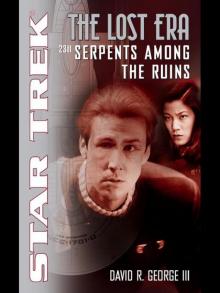 Serpents Among the Ruins
Serpents Among the Ruins The Fire and the Rose
The Fire and the Rose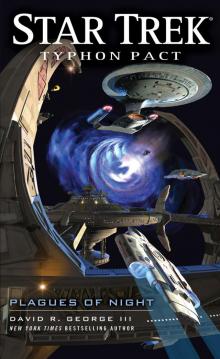 Star Trek: Typhon Pact 06: Plagues of Night
Star Trek: Typhon Pact 06: Plagues of Night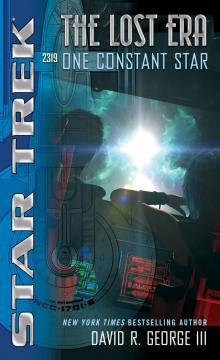 Star Trek: The Lost Era - 08 - 2319 - One Constant Star
Star Trek: The Lost Era - 08 - 2319 - One Constant Star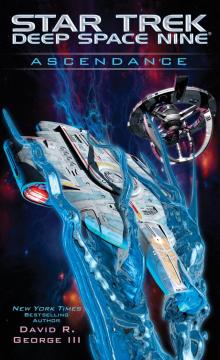 Star Trek: Deep Space Nine: Ascendance
Star Trek: Deep Space Nine: Ascendance Star Trek: TOS: Allegiance in Exile
Star Trek: TOS: Allegiance in Exile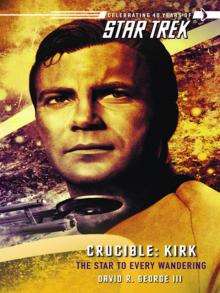 Crucible: Kirk
Crucible: Kirk Crucible: McCoy
Crucible: McCoy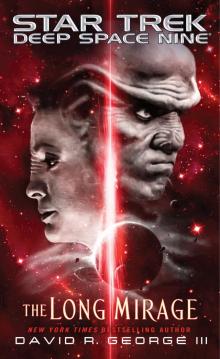 The Long Mirage
The Long Mirage Original Sin
Original Sin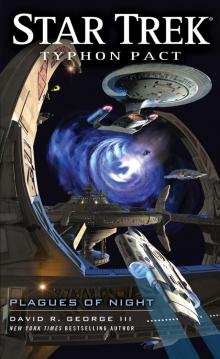 Star Trek: Typhon Pact: Plagues of Night
Star Trek: Typhon Pact: Plagues of Night Allegiance in Exile
Allegiance in Exile Sacraments of Fire
Sacraments of Fire Star Trek: Typhon Pact: Rough Beasts of Empire
Star Trek: Typhon Pact: Rough Beasts of Empire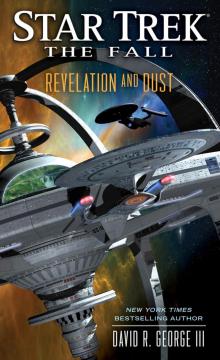 Star Trek: The Fall: Revelation and Dust
Star Trek: The Fall: Revelation and Dust